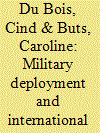| Srl | Item |
| 1 |
ID:
192039


|
|
|
|
|
| Summary/Abstract |
We explore the possibilities and limitations of models of the demand for military expenditures, as against additional kinds of cross-country analyses, with an empirical focus on the Indo-Pacific region. Our research bridges a gap between the Defence Economics and International Relations literatures by developing testable security alignment hypotheses and by testing these hypotheses in three ways: with demand modelling on total expenditures, with analyses on estimated stocks of imported armaments, and with qualitative analyses of trends in defence cooperation between states. We find consistent evidence across research methods of an increase in threat perceptions towards China since around 2012 and of balancing behaviour by US allies and by two non-allies. As compared to standard demand modelling, our hypothesis-based mixed methods approach allows for a clearer treatment of samples with mixed and shifting security alignments and of states that stabilise or reduce expenditures in the face of rising threat perceptions.
|
|
|
|
|
|
|
|
|
|
|
|
|
|
|
|
| 2 |
ID:
155836


|
|
|
|
|
| Summary/Abstract |
Extant literature documents a relationship between military deployment and the risk of an international terrorist attack against citizens of the deploying country. It appears that deployment significantly increases the possibility of terrorist actions in the home country. In particular, if country A decides to send troops to nation B, then citizens of the former country are more likely to fall victim of an attack carried out by a terrorist organisation originating from the latter country. Contributing to this line of literature, we further refine this relationship by distinguishing between regions where the troops are sent as well as by introducing differences between types of deployment. Our results indicate that missions to Asia and the Middle East are more dangerous than missions to other regions as reflected by the terrorist threat in the home country. Robustness tests do however show that the significance of the location variable Asia is predominantly attributed to the mission to Afghanistan. As for types of deployment, only ad hoc missions seem to increase the risk of an attack, whereas no significant results are found for other missions such as operations under UN and NATO flag. Leaving out the missions to Iraq and Afghanistan however also increases the danger resulting from missions by fixed coalitions. Our results find however no evidence that ‘wearing a blue helmet’ increases the probability of a terrorist attack at home.
|
|
|
|
|
|
|
|
|
|
|
|
|
|
|
|
| 3 |
ID:
189456


|
|
|
|
|
| Summary/Abstract |
This article discusses the effects of the changing (hybrid) conflict environment on the burden sharing debate. We discuss the actions taken by both the alliance as the member states in repelling these threats, arguing that this mainly produces security outputs that are private or impure public. As the burden sharing literature currently lacks notions of hybrid threats, we believe the current modelling to be ill-suited to provide reliable assessments of member states’ burden sharing behaviour. We address this void by adjusting the Joint Product Model, extending a country’s security activities to a more inclusive ‘whole of government (WoG) approach’. We depart from this WoG model to stress the challenges associated with comparing the contributions of member states in countering these threats. This leads us to dispute the use of aggregate military expenditures as a main variable to measure a country’s degree of free riding. More and other types of (non-military) variables and proxy-indexes should be taken into account. The same remark goes for estimating the benefit-burden concordance within this framework of permanent non-linear state competition.
|
|
|
|
|
|
|
|
|
|
|
|
|
|
|
|